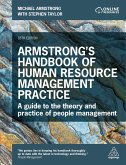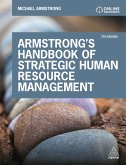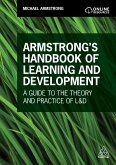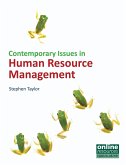Michael Armstrong, Stephen Taylor
Armstrong's Handbook of Human Resource Management Practice
A Guide to the Theory and Practice of People Management
Michael Armstrong, Stephen Taylor
Armstrong's Handbook of Human Resource Management Practice
A Guide to the Theory and Practice of People Management
- Gebundenes Buch
- Merkliste
- Auf die Merkliste
- Bewerten Bewerten
- Teilen
- Produkt teilen
- Produkterinnerung
- Produkterinnerung
Gain a complete understanding of how to develop all the key areas of the HR function with this one-stop shop handbook by the UK's bestselling HRM author.
Andere Kunden interessierten sich auch für
![Armstrong's Handbook of Human Resource Management Practice Armstrong's Handbook of Human Resource Management Practice]() Michael ArmstrongArmstrong's Handbook of Human Resource Management Practice207,99 €
Michael ArmstrongArmstrong's Handbook of Human Resource Management Practice207,99 €![Armstrong's Essential Human Resource Management Practice Armstrong's Essential Human Resource Management Practice]() Michael ArmstrongArmstrong's Essential Human Resource Management Practice55,99 €
Michael ArmstrongArmstrong's Essential Human Resource Management Practice55,99 €![Armstrong's Handbook of Strategic Human Resource Management Armstrong's Handbook of Strategic Human Resource Management]() Michael ArmstrongArmstrong's Handbook of Strategic Human Resource Management134,99 €
Michael ArmstrongArmstrong's Handbook of Strategic Human Resource Management134,99 €![Armstrong's Handbook of Learning and Development Armstrong's Handbook of Learning and Development]() Michael ArmstrongArmstrong's Handbook of Learning and Development191,99 €
Michael ArmstrongArmstrong's Handbook of Learning and Development191,99 €![Contemporary Issues in Human Resource Management Contemporary Issues in Human Resource Management]() Stephen TaylorContemporary Issues in Human Resource Management65,99 €
Stephen TaylorContemporary Issues in Human Resource Management65,99 €![The Oxford Handbook of Human Resource Management The Oxford Handbook of Human Resource Management]() The Oxford Handbook of Human Resource Management81,99 €
The Oxford Handbook of Human Resource Management81,99 €![Handbook of International Human Resource Management Handbook of International Human Resource Management]() Paul SparrowHandbook of International Human Resource Management122,99 €
Paul SparrowHandbook of International Human Resource Management122,99 €-
-
-
Gain a complete understanding of how to develop all the key areas of the HR function with this one-stop shop handbook by the UK's bestselling HRM author.
Produktdetails
- Produktdetails
- Verlag: Kogan Page Ltd
- 17 Revised edition
- Seitenzahl: 760
- Erscheinungstermin: 3. Januar 2026
- Englisch
- Abmessung: 234mm x 156mm
- ISBN-13: 9781398622104
- ISBN-10: 1398622109
- Artikelnr.: 71826500
- Herstellerkennzeichnung
- Libri GmbH
- Europaallee 1
- 36244 Bad Hersfeld
- gpsr@libri.de
- Verlag: Kogan Page Ltd
- 17 Revised edition
- Seitenzahl: 760
- Erscheinungstermin: 3. Januar 2026
- Englisch
- Abmessung: 234mm x 156mm
- ISBN-13: 9781398622104
- ISBN-10: 1398622109
- Artikelnr.: 71826500
- Herstellerkennzeichnung
- Libri GmbH
- Europaallee 1
- 36244 Bad Hersfeld
- gpsr@libri.de
Michael Armstrong is the UK's bestselling author of HRM books. With over a million copies sold, his books have been translated into 21 languages. Based in London, UK, he is managing partner of E-Reward and was previously a chief examiner of the Chartered Institute of Personnel and Development (CIPD). Stephen Taylor, Chartered CCIPD, is a senior lecturer in Human Resource Management at the University of Exeter Business School and a chief examiner for the CIPD.
Section
ONE: Fundamentals of human resource management; Chapter
01: The essence of HRM; Chapter
02: Human capital management; Chapter
03: The context of HRM; Chapter
04: The future of work; Chapter
05: HRM and organizational performance; Chapter
06: The ethical dimension of HRM; Chapter
07: Corporate social responsibility; Section
TWO: The strategic approach to HRM; Chapter
08: Strategic HRM; Chapter
09: HR strategy; Section
THREE: Delivering HR; Chapter
10: The role of HR; Chapter
11: The HRM role of line managers; Section
FOUR: Human resource management processes; Chapter
12: Evidence
based HRM; Chapter
13: HR analytics; Chapter
14: Digital HRM; Chapter
15: Knowledge Management; Chapter
16: AI in HRM Section
FIVE: Organization; Chapter
17: Organizational behaviour; Chapter
18: Organizational design; Chapter
19: Work design; Chapter
20: Job design; Chapter
21: Organizational development; Section
SIX: Factors affecting the behaviour of people at work; Chapter
22: Ability, motivation and opportunity; Chapter
23: Commitment; Chapter
24: Employee engagement; Section
SEVEN: People resourcing; Chapter
25: Resourcing strategy; Chapter
26: Workforce Planning; Chapter
27: Recruitment and selection; Chapter
28: Skill
based Recruitment; Chapter
29: Talent Management; Section
EIGHT: Employment practices; Chapter
30: The employee experience; Chapter
31: Managing employment; Chapter
32: Managing diversity and inclusion; Chapter
33: Managing flexibility; Chapter
34: Managing home and hybrid working; Section
NINE: Learning and development; Chapter
35: The basis of learning and development; Chapter
36: Strategic learning and development; Chapter
37: Organisational learning and the learning organization; Chapter
38: Individual learning; Chapter
39: The practice of learning and development; Chapter
40: The practice of learning and development; Chapter
41: Leadership and management development; Section
TEN: Performance management; Chapter
42: The basis of performance management; Chapter
43: Performance management; Chapter
44: Performance leadership; Section
ELEVEN: Reward management; Chapter
45: The bases of reward management; Chapter
46: Reward strategy; Chapter
47: The practice of reward management; Chapter
48: Managing reward for special groups; Chapter
49: Reducing the gender pay gap; Section
TWELVE: Employment relations; Chapter
50: The basis of employment relations; Chapter
51: Employment relations strategy; Chapter
52: The employment relationship; Chapter
53: The psychological contract; Chapter
54: The practice of industrial relations; Chapter
55: Employee voice; Chapter
56: Employee communications; Section
THIRTEEN: Employee wellbeing; Chapter
57: Principles and practice of employee wellbeing; Chapter
58: Health and Safety; Section
FOURTEEN: HR practices; Chapter
59: HR policies; Chapter
60: HR procedures; Chapter
61: Dealing with the legal aspects of employment; Section
FIFTEEN: International HRM; Chapter
62: The basis of international HRM; Chapter
63: The practice of international HRM; Chapter
64: Managing expatriates; Section
SIXTEEN: People management skills and competencies; Chapter
65: Strategic people management skills; Chapter
66: Business skills; Chapter
67: Dealing with business issues from an HR perspective; Chapter
68: Problem
solving and decision
making; Chapter
69: Analytical and critical skills; Chapter
70: Research skills; Chapter
71: Statistical skills; Chapter
72: Selection interviewing skills; Chapter
73: Job, role and skills analysis and competency modelling; Chapter
74: Learning and development skills; Chapter
75: Negotiating skills; Chapter
76: Change management; Chapter
77: Influencing skills; Chapter
78: Leadership; Chapter
79: Handling people problems; Chapter
80: Handling challenging conversations; Chapter
81: Managing conflict; Chapter
82: Recruitment
based skills; Chapter
83: Political skills; Chapter
84: Project management; Section
SEVENTEEN: Conclusion; Chapter
85: Trends in HRM
ONE: Fundamentals of human resource management; Chapter
01: The essence of HRM; Chapter
02: Human capital management; Chapter
03: The context of HRM; Chapter
04: The future of work; Chapter
05: HRM and organizational performance; Chapter
06: The ethical dimension of HRM; Chapter
07: Corporate social responsibility; Section
TWO: The strategic approach to HRM; Chapter
08: Strategic HRM; Chapter
09: HR strategy; Section
THREE: Delivering HR; Chapter
10: The role of HR; Chapter
11: The HRM role of line managers; Section
FOUR: Human resource management processes; Chapter
12: Evidence
based HRM; Chapter
13: HR analytics; Chapter
14: Digital HRM; Chapter
15: Knowledge Management; Chapter
16: AI in HRM Section
FIVE: Organization; Chapter
17: Organizational behaviour; Chapter
18: Organizational design; Chapter
19: Work design; Chapter
20: Job design; Chapter
21: Organizational development; Section
SIX: Factors affecting the behaviour of people at work; Chapter
22: Ability, motivation and opportunity; Chapter
23: Commitment; Chapter
24: Employee engagement; Section
SEVEN: People resourcing; Chapter
25: Resourcing strategy; Chapter
26: Workforce Planning; Chapter
27: Recruitment and selection; Chapter
28: Skill
based Recruitment; Chapter
29: Talent Management; Section
EIGHT: Employment practices; Chapter
30: The employee experience; Chapter
31: Managing employment; Chapter
32: Managing diversity and inclusion; Chapter
33: Managing flexibility; Chapter
34: Managing home and hybrid working; Section
NINE: Learning and development; Chapter
35: The basis of learning and development; Chapter
36: Strategic learning and development; Chapter
37: Organisational learning and the learning organization; Chapter
38: Individual learning; Chapter
39: The practice of learning and development; Chapter
40: The practice of learning and development; Chapter
41: Leadership and management development; Section
TEN: Performance management; Chapter
42: The basis of performance management; Chapter
43: Performance management; Chapter
44: Performance leadership; Section
ELEVEN: Reward management; Chapter
45: The bases of reward management; Chapter
46: Reward strategy; Chapter
47: The practice of reward management; Chapter
48: Managing reward for special groups; Chapter
49: Reducing the gender pay gap; Section
TWELVE: Employment relations; Chapter
50: The basis of employment relations; Chapter
51: Employment relations strategy; Chapter
52: The employment relationship; Chapter
53: The psychological contract; Chapter
54: The practice of industrial relations; Chapter
55: Employee voice; Chapter
56: Employee communications; Section
THIRTEEN: Employee wellbeing; Chapter
57: Principles and practice of employee wellbeing; Chapter
58: Health and Safety; Section
FOURTEEN: HR practices; Chapter
59: HR policies; Chapter
60: HR procedures; Chapter
61: Dealing with the legal aspects of employment; Section
FIFTEEN: International HRM; Chapter
62: The basis of international HRM; Chapter
63: The practice of international HRM; Chapter
64: Managing expatriates; Section
SIXTEEN: People management skills and competencies; Chapter
65: Strategic people management skills; Chapter
66: Business skills; Chapter
67: Dealing with business issues from an HR perspective; Chapter
68: Problem
solving and decision
making; Chapter
69: Analytical and critical skills; Chapter
70: Research skills; Chapter
71: Statistical skills; Chapter
72: Selection interviewing skills; Chapter
73: Job, role and skills analysis and competency modelling; Chapter
74: Learning and development skills; Chapter
75: Negotiating skills; Chapter
76: Change management; Chapter
77: Influencing skills; Chapter
78: Leadership; Chapter
79: Handling people problems; Chapter
80: Handling challenging conversations; Chapter
81: Managing conflict; Chapter
82: Recruitment
based skills; Chapter
83: Political skills; Chapter
84: Project management; Section
SEVENTEEN: Conclusion; Chapter
85: Trends in HRM
Section
ONE: Fundamentals of human resource management; Chapter
01: The essence of HRM; Chapter
02: Human capital management; Chapter
03: The context of HRM; Chapter
04: The future of work; Chapter
05: HRM and organizational performance; Chapter
06: The ethical dimension of HRM; Chapter
07: Corporate social responsibility; Section
TWO: The strategic approach to HRM; Chapter
08: Strategic HRM; Chapter
09: HR strategy; Section
THREE: Delivering HR; Chapter
10: The role of HR; Chapter
11: The HRM role of line managers; Section
FOUR: Human resource management processes; Chapter
12: Evidence
based HRM; Chapter
13: HR analytics; Chapter
14: Digital HRM; Chapter
15: Knowledge Management; Chapter
16: AI in HRM Section
FIVE: Organization; Chapter
17: Organizational behaviour; Chapter
18: Organizational design; Chapter
19: Work design; Chapter
20: Job design; Chapter
21: Organizational development; Section
SIX: Factors affecting the behaviour of people at work; Chapter
22: Ability, motivation and opportunity; Chapter
23: Commitment; Chapter
24: Employee engagement; Section
SEVEN: People resourcing; Chapter
25: Resourcing strategy; Chapter
26: Workforce Planning; Chapter
27: Recruitment and selection; Chapter
28: Skill
based Recruitment; Chapter
29: Talent Management; Section
EIGHT: Employment practices; Chapter
30: The employee experience; Chapter
31: Managing employment; Chapter
32: Managing diversity and inclusion; Chapter
33: Managing flexibility; Chapter
34: Managing home and hybrid working; Section
NINE: Learning and development; Chapter
35: The basis of learning and development; Chapter
36: Strategic learning and development; Chapter
37: Organisational learning and the learning organization; Chapter
38: Individual learning; Chapter
39: The practice of learning and development; Chapter
40: The practice of learning and development; Chapter
41: Leadership and management development; Section
TEN: Performance management; Chapter
42: The basis of performance management; Chapter
43: Performance management; Chapter
44: Performance leadership; Section
ELEVEN: Reward management; Chapter
45: The bases of reward management; Chapter
46: Reward strategy; Chapter
47: The practice of reward management; Chapter
48: Managing reward for special groups; Chapter
49: Reducing the gender pay gap; Section
TWELVE: Employment relations; Chapter
50: The basis of employment relations; Chapter
51: Employment relations strategy; Chapter
52: The employment relationship; Chapter
53: The psychological contract; Chapter
54: The practice of industrial relations; Chapter
55: Employee voice; Chapter
56: Employee communications; Section
THIRTEEN: Employee wellbeing; Chapter
57: Principles and practice of employee wellbeing; Chapter
58: Health and Safety; Section
FOURTEEN: HR practices; Chapter
59: HR policies; Chapter
60: HR procedures; Chapter
61: Dealing with the legal aspects of employment; Section
FIFTEEN: International HRM; Chapter
62: The basis of international HRM; Chapter
63: The practice of international HRM; Chapter
64: Managing expatriates; Section
SIXTEEN: People management skills and competencies; Chapter
65: Strategic people management skills; Chapter
66: Business skills; Chapter
67: Dealing with business issues from an HR perspective; Chapter
68: Problem
solving and decision
making; Chapter
69: Analytical and critical skills; Chapter
70: Research skills; Chapter
71: Statistical skills; Chapter
72: Selection interviewing skills; Chapter
73: Job, role and skills analysis and competency modelling; Chapter
74: Learning and development skills; Chapter
75: Negotiating skills; Chapter
76: Change management; Chapter
77: Influencing skills; Chapter
78: Leadership; Chapter
79: Handling people problems; Chapter
80: Handling challenging conversations; Chapter
81: Managing conflict; Chapter
82: Recruitment
based skills; Chapter
83: Political skills; Chapter
84: Project management; Section
SEVENTEEN: Conclusion; Chapter
85: Trends in HRM
ONE: Fundamentals of human resource management; Chapter
01: The essence of HRM; Chapter
02: Human capital management; Chapter
03: The context of HRM; Chapter
04: The future of work; Chapter
05: HRM and organizational performance; Chapter
06: The ethical dimension of HRM; Chapter
07: Corporate social responsibility; Section
TWO: The strategic approach to HRM; Chapter
08: Strategic HRM; Chapter
09: HR strategy; Section
THREE: Delivering HR; Chapter
10: The role of HR; Chapter
11: The HRM role of line managers; Section
FOUR: Human resource management processes; Chapter
12: Evidence
based HRM; Chapter
13: HR analytics; Chapter
14: Digital HRM; Chapter
15: Knowledge Management; Chapter
16: AI in HRM Section
FIVE: Organization; Chapter
17: Organizational behaviour; Chapter
18: Organizational design; Chapter
19: Work design; Chapter
20: Job design; Chapter
21: Organizational development; Section
SIX: Factors affecting the behaviour of people at work; Chapter
22: Ability, motivation and opportunity; Chapter
23: Commitment; Chapter
24: Employee engagement; Section
SEVEN: People resourcing; Chapter
25: Resourcing strategy; Chapter
26: Workforce Planning; Chapter
27: Recruitment and selection; Chapter
28: Skill
based Recruitment; Chapter
29: Talent Management; Section
EIGHT: Employment practices; Chapter
30: The employee experience; Chapter
31: Managing employment; Chapter
32: Managing diversity and inclusion; Chapter
33: Managing flexibility; Chapter
34: Managing home and hybrid working; Section
NINE: Learning and development; Chapter
35: The basis of learning and development; Chapter
36: Strategic learning and development; Chapter
37: Organisational learning and the learning organization; Chapter
38: Individual learning; Chapter
39: The practice of learning and development; Chapter
40: The practice of learning and development; Chapter
41: Leadership and management development; Section
TEN: Performance management; Chapter
42: The basis of performance management; Chapter
43: Performance management; Chapter
44: Performance leadership; Section
ELEVEN: Reward management; Chapter
45: The bases of reward management; Chapter
46: Reward strategy; Chapter
47: The practice of reward management; Chapter
48: Managing reward for special groups; Chapter
49: Reducing the gender pay gap; Section
TWELVE: Employment relations; Chapter
50: The basis of employment relations; Chapter
51: Employment relations strategy; Chapter
52: The employment relationship; Chapter
53: The psychological contract; Chapter
54: The practice of industrial relations; Chapter
55: Employee voice; Chapter
56: Employee communications; Section
THIRTEEN: Employee wellbeing; Chapter
57: Principles and practice of employee wellbeing; Chapter
58: Health and Safety; Section
FOURTEEN: HR practices; Chapter
59: HR policies; Chapter
60: HR procedures; Chapter
61: Dealing with the legal aspects of employment; Section
FIFTEEN: International HRM; Chapter
62: The basis of international HRM; Chapter
63: The practice of international HRM; Chapter
64: Managing expatriates; Section
SIXTEEN: People management skills and competencies; Chapter
65: Strategic people management skills; Chapter
66: Business skills; Chapter
67: Dealing with business issues from an HR perspective; Chapter
68: Problem
solving and decision
making; Chapter
69: Analytical and critical skills; Chapter
70: Research skills; Chapter
71: Statistical skills; Chapter
72: Selection interviewing skills; Chapter
73: Job, role and skills analysis and competency modelling; Chapter
74: Learning and development skills; Chapter
75: Negotiating skills; Chapter
76: Change management; Chapter
77: Influencing skills; Chapter
78: Leadership; Chapter
79: Handling people problems; Chapter
80: Handling challenging conversations; Chapter
81: Managing conflict; Chapter
82: Recruitment
based skills; Chapter
83: Political skills; Chapter
84: Project management; Section
SEVENTEEN: Conclusion; Chapter
85: Trends in HRM








